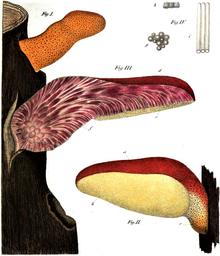
Back الناسور الكبدى ARZ Fistulina hepatica AST Фістуліна пячоначная Byelorussian Чернодробна гъба Bulgarian Fetge de vaca Catalan Fistulina hepatica CEB Pstřeň dubový Czech Eichen-Leberreischling German Fistulina hepatica Spanish Maksak Estonian
| Fistulina hepatica | |
|---|---|

| |
| Beefsteak fungus | |

| |
| Carlo Vittadini: Fistulina hepatica (1835) | |
| Scientific classification | |
| Domain: | Eukaryota |
| Kingdom: | Fungi |
| Division: | Basidiomycota |
| Class: | Agaricomycetes |
| Order: | Agaricales |
| Family: | Fistulinaceae |
| Genus: | Fistulina |
| Species: | F. hepatica
|
| Binomial name | |
| Fistulina hepatica | |
| Synonyms | |
|
Boletus hepaticus Schaeff. (1774) | |
| Fistulina hepatica | |
|---|---|
| Pores on hymenium | |
| Cap is flat or offset | |
| Hymenium is decurrent | |
| Stipe is bare | |
| Spore print is pink | |
| Ecology is parasitic | |
| Edibility is choice | |
Fistulina hepatica, commonly known as the beefsteak fungus, beefsteak polypore, poor man’s steak, ox tongue, or tongue mushroom, is an unusual bracket fungus classified in the Agaricales, that is commonly seen in Britain and the rest of Europe, but which can also be found in North America, Australia, North Africa, and Southern Africa. As its name suggests, it looks remarkably similar to a slab of raw meat. It has been used as a meat substitute in the past, and can still be found in some French markets. It has a sour, slightly acidic taste. For eating, it must be collected young and it may be tough and need to be cooked for a long time.